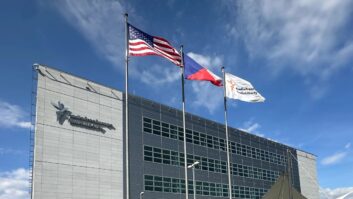
A man of many interests, Laird trained with Keith Code at California Superbike School but totaled his racing bike in 2008 and hung up his racing leathers. He still rides street on a classic BMW. Andy Laird’s lifelong mantra of “doing it right” has served him well throughout a 50-year career as a broadcast engineer.
A self-professed audiophile, he said his goal as a chief was to originate the best-sounding product and then pass it through the transmit and receive system with the least harm.
He also owns what is generally regarded as one of the best sets of ears in the broadcast business. A fellow broadcast engineer deemed Laird a “Golden Ears,” a special industry compliment.
Now he has another.
Laird, 72, is this year’s recipient of the NAB Radio Engineering Achievement Award. It recognizes people who have made significant contributions to broadcast engineering. Richard Chernock of Triveni Digital was chosen for the TV Engineering Achievement Award, while Adam Symson of The E.W. Scripps Company will receive the Digital Leadership Award. They will be honored in Las Vegas during April’s NAB Show.
Laird retired as vice president and chief technology officer for Journal Broadcast Group in 2015 after spending much of his career on the cutting edge of broadcast technology.
His involvement with the National Radio Systems Committee was crucial to the evolution and standardization of the system for digital AM and FM in the United States, according to NAB. NRSC is the technical standards setting body co-sponsored by NAB and the Consumer Technology Association. Until recently, Laird was the co-chair of its Digital Radio Broadcasting subcommittee.

Andy Laird Laird began his career in the 1960s developing audio processors and designing and building radio facilities. His first job was at Denver’s KWGN(TV) as staff engineer, then he was hired a year later at KLAK(AM) in that same city as chief engineer, according to NAB.
By 1972 Laird was in Los Angeles at KDAY(AM) as CE. He remained there until 1988, when he joined Heritage Media and took on some major rebuilding projects. Heritage later sold most of its radio stations to Sinclair Broadcast Group. Laird moved to Journal Broadcast Group in 1998 to oversee engineering operations for the group’s TV and radio properties.
Laird also worked as a studio design consultant on many projects for a variety of customers and radio groups throughout his career.
LISTENING WITH CARE
Laird had been set to become a physicist — he has a Bachelor of Science degree in physics with a minor in math from Principia College in southern Illinois — but the lure of working with audio in the broadcasting industry was too much to resist. After all, this is a man who has played seven musical instruments, beginning with piano when he was 5.
Having a critical ear when listening to audio of any kind should be important to every broadcast engineer, Laird said.
“An educated ear is the best test equipment available. Ear development for me happened as a young kid,” he said.
“I’d record a piano on a disc recorder at home and wonder why it didn’t sound like it did when I played it. That was part of my initial curiosity and development as an audiophile. My career really was just an extension of that.”

Laird was general manager of KVDU at the University of Denver as a grad student in 1965. Laird, who was quick to offer recommendations for better audio to equipment manufacturers, began his radio projects with the idea of building a broadcast plant to the highest fidelity standard available.
“My educated ear philosophy says you can’t just look at test equipment and make subjective judgments that are necessary to build a superior facility. A broadcast engineer needs to learn sounds that different equipment makes and when you hear it know where to go. It’s a huge time-saver when you can do that.”
Laird’s hearing ability came into play during the development of HD Radio, which was submitted for technical review to the NRSC.
“We went through many iterations of what a digital system could sound like for AM and FM. Early on, there were so many different codecs, and it was really subjective as to what sounded best. We had to design subjective tests for the various codecs being presented so we could develop definitive data,” Laird said. “That work we did was critical to the process.”
After the first round of testing, the NRSC suspended work, allowing proponents to develop their systems further. Eventually some stopped development while two merged to form iBiquity, which later asked that the committees be reactivated to evaluate the revised system.
Laird spent more than 20 years on the NRSC and held various leadership roles, including chair of the Test Guidelines Working Group and Test Procedures Working Group, which were responsible for developing the procedures used in the NRSC’s evaluation of the IBOC-DAB standard.
“I’m very satisfied with our work. The HD Radio audio quality on FM is very, very good. It’s substantially better than analog. I believe HD Radio is growing at its expected pace to this point,” Laird said.
Asked how he felt about AM HD Radio, Laird said, “Hybrid AM IBOC works really well on some stations, not all. Both the FM and AM IBOC hybrid operations are intended to be transitional. It may be that pure AM digital mode (supported by all IBOC receivers) will have its biggest impact on AM. All-digital AM testing will help answer that question.”

Laird turns on the AM IBOC at WTMJ in 2004. IBOC for AM was FCC-approved only as a daytime service at the time.DEMANDING EXCELLENCE
Laird’s peers on the NRSC admired his preparation and attention to detail when leading discussions on a range of topics, from IBOC-DAB to improving the quality of AM radio and setting the RBDS standard.
Mike Starling, former vice president of NPR Labs, cites Laird’s persuasiveness in demanding audio excellence as a key attribute.
“Andy singlehandedly convinced my bosses at NPR that there really was a problem with the PAC codec during a critical listening session, even though none of them could hear it,” Starling said. “[Laird’s] articulate horror and description of the artifacts he could hear spoke for the 30 engineers in the room.”
Milford Smith, vice president of engineering at Greater Media and current chairman of the NRSC, said Laird’s work and contributions with the group are well documented.
“Andy was always a valued contributor to that organization’s work but never more so than during the more than decade-long evaluation and ultimately standardization of the system for digital AM and FM radio broadcasting in the U.S.,” Smith said.
“More specifically, in addition to his active participation in the entire process, start to finish, Andy was chairman of the critical Test Procedures Working Group, which literally formulated from scratch the detailed and comprehensive test procedures for a transmission technology never before evaluated in any forum.”
The thoroughness of Laird’s work and the incremental results of such testing identified areas in need of improvement, which resulted in significant changes to the originally proposed technology, Smith said.
It was Smith who bestowed the golden ear moniker upon Laird. “[He has] what many consider to be the best set of ears in the business.”

Skiing in Vail. Laird’s interests include music, scuba diving, sailing and weightlifting, in which he holds a national record for his age group. For those lucky enough to be in Laird’s company at previous NAB Shows, the experience was priceless, according to Rick Kemp, who works in engineering sales at broadcast parts supplier BSW.
“One of my favorite things to do at NAB is to do the Radio Hall floor walk with Andy. But don’t be in a hurry,” Kemp cautioned.
“Broadcast engineers and personalities alike will stop him mid-walk to say hello shake his hand and thank him for the consulting work he did for them years ago. This would then be followed by a brief but detailed history of the station, the problem he was asked to provide a solution for. This often prompted a detailed explanation of his solution over lunch or dinner, including the math or logic and how to avoid a similar problem in the future.”
Kemp said Laird’s contributions to broadcasting in HD Radio, antenna design and audio processing are illustrious.
Tom Silliman, president of Electronics Research Inc., summed up Laird’s analytical style of management with an anecdote: “My last encounter with Andy regarded a tower failure in Kansas from an unusual storm with excessive straight-line winds that resulted in the top of Andy’s tower ending up in a corn field. Andy approached this accident with his usual calm, logical, engineering based response.”
HONOR ROLL
Recipients of the NAB Engineering Achievement Award are listed here. Beginning in 1991, radio and TV winners were named; radio winners are shown.
1959 John T. Wilner
1960 T.A.M. Craven
1961 Raymond F. Guy
1962 Ralph N. Harmon
1963 Dr. George R. Town
1964 John H. DeWitt Jr.
1965 Edward W. Allen Jr.
1966 Carl J. Meyers
1967 Robert M. Morris
1968 Howard A. Chinn
1969 Jarrett L. Hathaway
1970 Philip Whitney
1971 Benjamin Wolfe
1972 John M. Sherman
1973 A. James Ebel
1974 Joseph B. Epperson
1975 John D. Silva
1976 Dr. Frank G. Kear
1977 Daniel H. Smith
1978 John A. Moseley
1979 Robert W. Flanders
1980 James D. Parker
1981 Wallace E. Johnson
1982 Julius Barnathan
1983 Joseph Flaherty
1984 Otis S. Freeman
1985 Carl E. Smith
1986 Dr. George Brown
1987 Renville H. McMann
1988 Jules Cohen
1989 William Connolly
1990 Hilmer Swanson
1991 George Marti
1992 Edward Edison & Robert L. Hammett
1993 Robert M. Silliman
1994 Charles T. Morgan
1995 Robert Orban
1996 Ogden Prestholdt
1997 George Jacobs
1998 John Battison
1999 Geoffrey Mendenhall
2000 Michael Dorrough
2001 Arno Meyer
2002 Paul Schafer
2003 John W. Reiser
2004 E. Glynn Walden
2005 Milford Smith
2006 Benjamin Dawson & Ronald Rackley
2007 Louis A. King
2008 Thomas B. Silliman
2009 Jack Sellmeyer
2010 Steve Church
2011 L. Robert du Treil
2012 Paul Brenner
2013 Frank Foti
2014 Jeff Littlejohn
2015 Thomas F. King
2016 Andy Laird
“DON’T MAKE ME NORMAL”
Then there’s the other Andy Laird, the adventure-seeker. If Dos Equis beer is looking for a “World’s Most Interesting Man in Tech,” we might suggest Andy Laird.
How many engineers — how many people — do you know who have played the euphonium (and six other instruments), sailed with friends from Argentina to Antarctica, scuba dived under icebergs, rode MotoGP and set the national dead-lift record for 70+ year olds by lifting 446 pounds at the Natural Athlete Strength Association 2014 Masters Nationals? Sheesh.
Why is he drawn to such diverse and challenging endeavors? Is there a philosophy behind it?
“I remember at a young age wondering about a line from the 1952 Broadway play The Fantasticks: ‘Please God please, don’t make me normal,’” he said.
“What does that mean? For me it means acting on what interests me, not just dreaming about it. Normal is being limited by ‘I can’t do that.’ You have no idea what you can do until you actually go out and do it.”
He recommends visualizing what you want to help make dreams into reality. “This process plants a goal into the subconscious mind so you can recognize the opportunities to advance on it as they come available.”
The expedition to Antarctica came about that way. “Since I was a kid, I’ve dreamed about seeing Antarctica, so distant, so exotic, so out of this world.” So he was ready for the experience of a lifetime when a fellow adventurer mentioned he was in the process of putting together a sailing, hiking, kayaking and diving expedition, and needed someone with cold-water diving skills.
“As to being drawn to physically challenging things, it must be in my genes. My dad had six world’s records in skeet shooting and several in hydroplane racing. Also he was a factory racer for Indian Motorcycles in the 1920s. My sister says I didn’t fall far from the tree.”
Meantime, Laird also continues to be active in radio in retirement. He travels often as a freelance consultant for E.W. Scripps, working with its radio properties, which were acquired from Journal Communications in 2015. Scripps spun off Journal’s publishing operations while keeping the radio and TV properties.
“It’s just been a fabulous way to transition into retirement. Consulting gives me a lot of flexibility. I’m doing some market travel. Right now I’m helping [Scripps] with a potential relocation of five stations and offices of theirs in Springfield, Mo.,” Laird said.
Laird resides with his wife, Donna, in Milwaukee, Wis.
Read Radio World Engineering Extra’s 2014 interview with Laird atwww.radioworld.com/laird.







